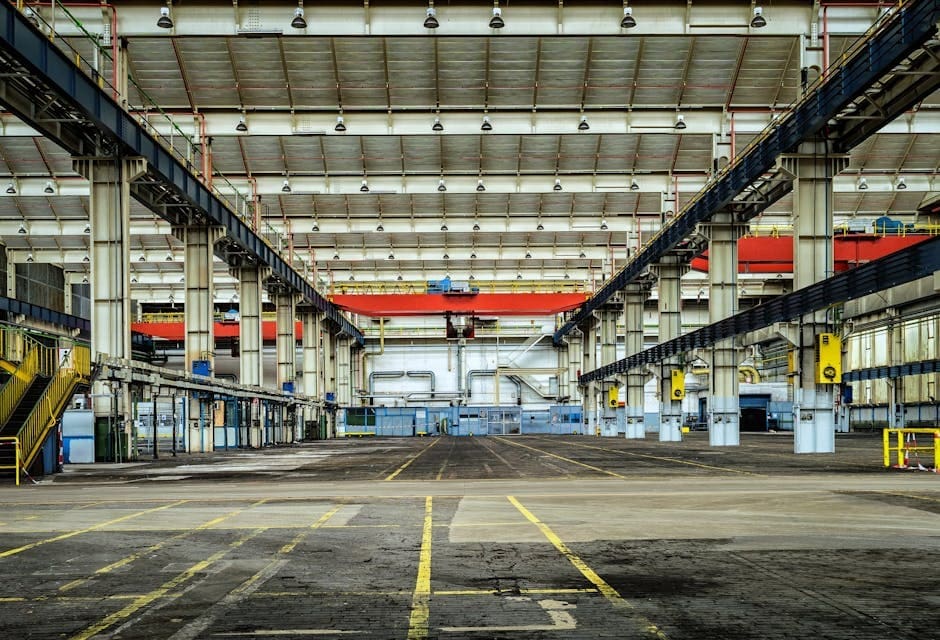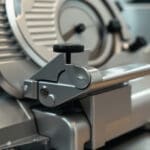Manufacturing efficiency is all about maximizing output while minimizing costs. This ensures factories produce high-quality products fast, and at lower costs, leading to better productivity and profits.
- Evaluate Procedures: Review current workflows to spot and fix inefficiencies.
- Adopt Best Practices: Use strategies like lean manufacturing to boost productivity.
- Leverage Technology: Incorporate automation and advanced tools for seamless operations.
In today’s market, manufacturing efficiency is key to staying competitive. It aligns with industry standards like ISO and lean principles, paving the way for sustainability and operational excellence. As demand grows and tech advances, boosting operational efficiency can set companies apart. Whether through Graco’s automated lubrication systems or innovative packaging solutions from BE Machinery, achieving operational efficiency improves productivity and reliability.
I’m Todd Cleppe, the CEO of CFAB Global, with over 25 years of experience in improving machinery efficiency. My expertise spans the food packaging, steel, and mining sectors. I’ve seen how enhancing manufacturing efficiency can cut costs and boost output. This journey has made me passionate about delivering sustainable machinery solutions.

Simple manufacturing efficiency glossary:
– how to calculate efficiency
– industrial machinery efficiency
Understanding Manufacturing Efficiency
Manufacturing efficiency is the art of producing more with less. It’s about balancing productivity, quality, and cost. When done right, manufacturers can create top-notch products quickly and cheaply.
Production Efficiency: Getting More from Less
Production efficiency is all about maximizing output while minimizing input. Think of it as a ratio: how much product you make versus the resources you use. The goal? Produce more with fewer resources. This isn’t just about speed; it’s about using materials, labor, and time wisely.
In a competitive market, companies like Tesla have shown how redesigning production processes can slash costs significantly. This kind of innovation drives efficiency and keeps businesses ahead.
Quality and Effectiveness: Beyond Just Numbers
Efficiency isn’t just about numbers. It’s also about quality and effectiveness. A factory can be fast, but if the products are flawed, it’s not truly efficient. High-quality production means fewer defects, less waste, and happier customers.
For instance, consider the role of BE Machinery’s packaging solutions in maintaining high standards in food processing. Their systems ensure that products meet safety and quality requirements, which is crucial for effective manufacturing.
Cost-Effective Production: Saving Money While Making Money
Cost-effective production is the sweet spot where efficiency meets profitability. By reducing waste and optimizing processes, manufacturers can lower costs without sacrificing quality. This leads to better margins and more competitive pricing.
Lean manufacturing is a prime example of this. Originating from Toyota, it focuses on eliminating waste and adding value at every step. By adopting these principles, manufacturers can streamline operations and cut unnecessary expenses.
In summary, understanding manufacturing efficiency involves more than just speeding up the assembly line. It’s about creating a harmonious balance between production, quality, and cost. This holistic approach not only boosts output but also ensures products are effective and cost-efficient.
Calculating Manufacturing Efficiency
Calculating manufacturing efficiency is like finding the heartbeat of your production process. It tells you how well you’re doing and where you can improve. Let’s break it down into simple steps.
Efficiency Formula: The Basics
The formula for manufacturing efficiency is straightforward:
Manufacturing Efficiency (%) = (Standard Output / Actual Output) x 100
This equation helps you see how close you are to the ideal production scenario. A score of 100% means you’re hitting the mark perfectly, while anything less indicates room for improvement.
Understanding Standard Output
Standard output is your benchmark. It’s the production level you aim to achieve under optimal conditions. This can be derived from historical data, industry standards, or competitor benchmarks. For example, if your industry standard is to produce a widget at $1.50, this figure becomes your target.
Determining Actual Output
Actual output is what you achieve in reality. It’s calculated using your total input and output:
Actual Output = Total Input / Total Output
Imagine you produce 50 pairs of sandals for $100. Here, each pair costs $2, which is your actual output per unit.
Putting It All Together
Let’s say you want to compare your efficiency against a competitor who produces 55 widgets for $100, while your actual output is $2 per widget. The standard output is $1.50 per widget.
Using the formula:
- Calculate Actual Output per Unit: $2
- Standard Output per Unit: $1.50
- Efficiency: (1.50 / 2) x 100 = 75%
This calculation shows you’re operating at 75% efficiency, meaning there’s a 25% gap to close.
Why It Matters
Understanding these numbers helps you make informed decisions. If your efficiency is below par, it might be time to explore options like BE Machinery’s advanced automation solutions for better resource utilization or Graco’s industrial fluid management systems to cut unnecessary costs.
By keeping a close eye on these metrics, you can continuously improve and stay competitive in the manufacturing landscape.
Strategies to Improve Manufacturing Efficiency
Lean Manufacturing Principles
Lean manufacturing is about doing more with less. Originating from Toyota, this approach focuses on eliminating waste while maintaining quality. Waste in manufacturing can take many forms, like excess inventory or unnecessary movements.
How to Implement Lean Manufacturing:
-
Identify Waste: Look for areas where resources aren’t adding value. This could be time, materials, or labor.
-
Standardize Processes: Create consistent procedures to minimize errors and increase efficiency. This ensures everyone is on the same page and reduces the chance of mistakes.
-
Continuous Improvement: Always seek ways to improve processes. Even small changes can lead to significant efficiency gains over time.
Accept Technology and Automation
Incorporating technology and automation can significantly boost manufacturing efficiency. By reducing manual tasks, you free up time for more critical activities.
Steps to Accept Technology:
-
Invest in Automation: Consider automated systems for repetitive tasks. For instance, BE Machinery’s solutions can streamline food packaging processes, enhancing productivity.
-
Monitor Machines: Use machine monitoring tools to track performance and predict maintenance needs. This minimizes downtime and ensures smooth operations.
-
Leverage Data Analytics: Analyze performance data to gain insights into production trends. This helps identify areas for improvement and optimize resource allocation.
Employee Training and Engagement
Your workforce is your most valuable asset. Investing in their development can lead to significant improvements in manufacturing efficiency.
Ways to Foster Employee Development:
-
Continuous Training: Offer regular training sessions to keep employees updated on the latest technologies and practices. This boosts their skills and confidence.
-
Encourage Engagement: Create an environment where employees feel valued and motivated. Engaged workers are more productive and less likely to leave.
-
Promote Collaboration: Encourage teamwork and open communication. When employees share ideas and solutions, it leads to innovation and efficiency gains.
By focusing on these strategies, you can improve your manufacturing processes and stay competitive. Accept lean principles, leverage technology, and invest in your workforce to boost efficiency and productivity.
Frequently Asked Questions about Manufacturing Efficiency
How do you measure manufacturing efficiency?
Manufacturing efficiency is measured using a straightforward formula: Standard Output / Actual Output. This formula helps you understand how well your production process is performing compared to an ideal scenario.
- Standard Output is the target set based on industry standards or historical data.
- Actual Output refers to the real production numbers achieved.
By calculating this, you can see how close you are to achieving optimal efficiency. It’s like having a report card for your factory’s performance.
What is a good production efficiency?
In manufacturing, a “good” production efficiency varies by industry. However, a common benchmark is the Overall Equipment Efficiency (OEE), which combines three critical factors: performance, quality, and rate.
- Performance measures how well equipment is running compared to its maximum potential.
- Quality checks the percentage of products that meet quality standards.
- Rate considers the speed of production.
An OEE score of 85% is considered world-class, but this can vary. Always compare your efficiency to industry standards to know where you stand.

How can technology improve manufacturing efficiency?
Technology is a game-changer in boosting manufacturing efficiency. Here’s how:
-
Advanced Analytics: By using data analytics, you can gain insights into production trends and identify bottlenecks. This data-driven approach allows for informed decision-making and process optimization.
-
Digital Change: Embracing digital tools can streamline operations. For example, automated systems reduce manual tasks, freeing up time for more strategic activities. Consider solutions like BE Machinery’s advanced packaging systems for efficiency gains.
-
Real-time Monitoring: Implement real-time monitoring to track machine performance and predict maintenance needs. This proactive approach minimizes downtime and keeps production running smoothly.
By integrating these technologies, you can improve your production processes, reduce waste, and stay competitive in the changing manufacturing landscape.
Conclusion
At CFAB Global, we understand that achieving peak manufacturing efficiency is crucial for your business success. That’s why we offer our exclusive Machine Reliability Program, designed to improve the performance, reliability, and lifespan of your machinery.
Our Machine Reliability Program isn’t a one-size-fits-all solution. We tailor our approach to meet your specific needs, ensuring that you get the most out of your equipment. From personalized analysis to cutting-edge services and high-quality equipment, we’re committed to helping you achieve maximum productivity and reduce costly downtime.
Our team works closely with you every step of the way—from initial consultation to post-implementation support. This ensures your machinery operates at peak performance, delivering measurable results that drive your business forward.
By choosing CFAB Global, you benefit from:
- Expertise: Our specialists bring years of industry experience to provide top-tier support.
- Customized Solutions: We address your unique machinery needs and challenges with our custom programs.
- Proactive Maintenance: Our focus on predictive maintenance strategies prevents breakdowns before they occur.
- Increased ROI: By minimizing downtime and extending machinery lifespan, we help you maximize your return on investment.
Explore our Machine Reliability Program to see how CFAB Global can transform your manufacturing operations. Let us be your trusted partner in achieving operational excellence and sustained growth.






